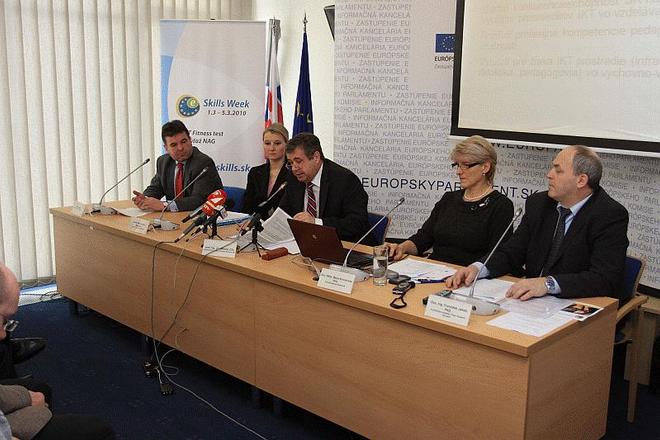MOST Slovaks are only apprentices in using information technology and the most commonly used online service in Slovakia is internet banking. These were two of the findings from European e-Skills Week 2010, a programme aimed at raising awareness of the growing demand for highly-skilled IT practitioners and developing more sophisticated users of information technology. The first European e-Skills Week was held in March 2010 and Slovakia was a participant. Preparations of the activities for the second edition, scheduled for the week of March 26-30, 2012, are nearly complete but some preliminary activities will start on February 15. Slovakia’s e-Skills Week 2012 will feature two primary activities: an IT Fitness Test and the final national round of the Networking Academy Games.
“These activities raise the interest of students in IT studies and the IT testing provides information on how target groups, particularly young people, are able to use information and communication technology (ICT) for their needs in life, in school and so forth,” Gustáv Budinský, the executive manager of the IT Association of Slovakia (ITAS), one of the organisers here, told The Slovak Spectator. “The results of the tests help in preparation of studies and recommendations on how to alter study programmes in the ICT field so that the skills of school graduates improve and they are better prepared.”
ITAS is participating in this programme as a member of DIGITALEUROPE and is closely cooperating with the Ministry of Education, a member of the European Schoolnet (EUN). European e-Skills Week 2012 is the result of joint efforts by DIGITALEUROPE, EUN and European Commission’s Directorate-General for Enterprise and Industry.
Beata Brestenská from the Faculty of Natural Sciences of Comenius University, who is participating in the preparation of questions for the IT Fitness Test, sees many benefits flowing from the week.
“Huge financial resources are invested into IT from the state budget and EU funds,” Brestenská told The Slovak Spectator. “But we are not able to objectively answer certain questions: What is the effectiveness of the invested funds? How are the competencies needed for work with ICT developed in the younger generation? Does the current process of education reflect the needs of an information society?”
Brestenská is confident that the activities of the second European e-Skills Week will help provide answers to these questions.
The IT Fitness Test
The goal of the IT Fitness Test is to determine the level of basic IT skills of the target group of young people up to age 30, their ability to effectively use IT in their studies, in work and in everyday lives, but the test is also open to anyone who is interested in participating. The online test will be available at www.eskills.sk between February 15 and March 15.
“We are working intensively on preparations for the test,” Budinský said. “The 2012 test is already prepared and the website is undergoing endurance testing so that it can cope with the huge number of students eager to test their knowledge.”
In 2010 over 55,000 people participated in the first edition of the IT Fitness Test and almost 40,000 of them had their tests evaluated.
“The results from the test showed that basic knowledge about use of IT is quite good, but IT skills and effective use of information resources among various professions are not yet satisfactory,” Brestenská stated, adding that the average score among Slovaks was 38.5 percent, putting them in the category of ‘IT apprentice’.
A detailed analysis of the results and recommendations for improving education in IT-related subjects at elementary and secondary schools, as well as at universities, were provided to the Education Ministry as well as to the IT sector.
A part of the IT Fitness Test showed that the younger generation in Slovakia does not have any problem with availability of hardware and that the internet is available in over 95 percent of schools and 70 percent of households. Compared with other OECD countries, young Slovaks use digital technologies more often at school than at home, while in most other OECD countries students use digital technologies much more at home than in school.
“A surprising finding was that 89 percent of young people are on social networks,” said Brestenská. “This is a new phenomenon that might be used in a more targeted way for education.”
The 2010 test also showed that young people rely too much on Google and Wikipedia as their primary sources of information and they do not verify their findings in other ways, Brestenská said, adding that one of the past recommendations was to teach about other information sources in schools so that young people look at information they find more critically and learn to use specialised libraries, databases and other information resources.
The test showed that Slovaks have the biggest gap in knowledge in the area of information security, Brestenská said, while adding they were quite skilful in searching for information on the internet. The most used internet-based services were internet banking (29 percent), booking tickets (25 percent) and arranging accommodation and flight tickets (14 percent).
“The results of the IT Fitness Test showed that most Slovaks use only the basic amenities of ICT,” said Juraj Sabaka, the president of ITAS. “The actual results for many respondents were worse than they had expected, even though they were of no surprise to me. The test showed gaps in education or in ICT use in the educational process.”
Slovakia helps its neighbours


 IT test in 2010 brought several interesting findings. (source: ITAS)
IT test in 2010 brought several interesting findings. (source: ITAS)